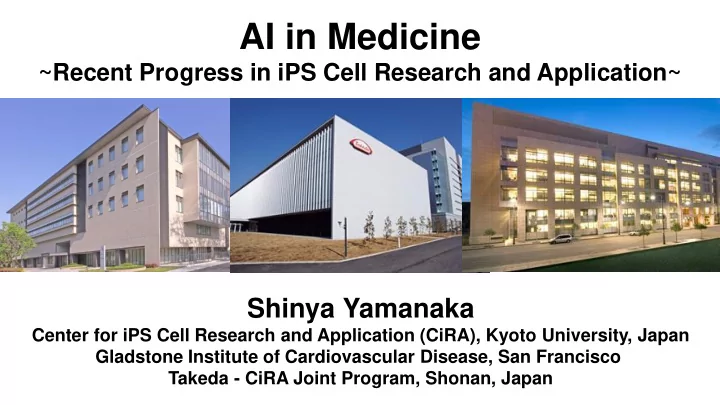

AI in Medicine ~Recent Progress in iPS Cell Research and Application~ Shinya Yamanaka Center for iPS Cell Research and Application (CiRA), Kyoto University, Japan Gladstone Institute of Cardiovascular Disease, San Francisco Takeda - CiRA Joint Program, Shonan, Japan
Generation of iPS cells Oct3/4 Sox2 Klf4 c-Myc Skin cells iPS Cells ( i nduced P luripotent S tem cells) Human Mouse 2007 2006
Applications of iPS cells Skin cells iPS cells Blood cells Regenerative Medicine Drug Development Neurons Muscle Heart Hepatic cells cells cells
iPS Cell-Based Cell Therapy For Age-related Macular Degeneration (2014) Retinal Cells No rejection No tumors Vision: stabilized Dr. Masayo Takahashi ( RIKEN, BDR ) (Photo by RIKEN)
Autologous iPS Cells Transplantation Differentiated iPS cells cells Sample Quality Quality check check collection Autograft: Too expensive and time-consuming iPS Cell Stock for Regenerative Medicine
HLA Homozygous “Super” Donors HLA homozygous donor To reduce the cost & time of autologous iPSC
iPS Cell Stock for Regenerative Medicine Japanese Red Cell Processing Facility at CiRA Cross Society Platelet / Bone Marrow Informed Consent & Donors Blood Sampling Clinical-grade Quality Stock iPS Cells Check “HLA Super Donors” Informed Consent Distribution started from 2015 7 donors Cord Blood (Top 4 frequent HLA haplotypes among Japanese) Banks : Covering ~40% of Japanese population
Center for iPS Cell Research and Application (CiRA) Goal: To realize medical applications of iPS Cells Started in April, 2010 14 Cell Processing Rooms
Clinical Application Using iPS Cell Stock Clinical Research 2019.8.29 Masayo Takahashi Lab. (RIKEN) Kohji Nishida Lab. (Osaka Univ.) Age-related Macular Degeneration Cornea Epithelial Stem Cell Exhaustion Clinical Trial Jun Takahashi Lab. (CiRA) Yoshiki Sawa Lab. (Osaka Univ.) Parkinson’s Disease Ischemic cardiomyopathy
Clinical Application Using iPS Cell Stock Approved by MHLW 時事通信社 2019.2.19 Hideyuki Okano Lab. (Keio Univ.) Noriyuki Tsumaki Lab. (CiRA) Spinal Cord Injury Articular Cartilage Injury University approved 産経新聞 Keiichi Fukuda Lab. (Keio Univ.) Dilated cardiomyopathy Osaka Univ. Retinitis Pigmentosa
Regenerative Medicine Using iPS Cell Stock Parkinson’s Disease Neurons Retinal cells iPS Cells Corneal cells Platelets Blood transfusion Ischemic cardiomyopathy Heart Muscle cells Dilated cardiomyopathy Neural stem cells Liver cells Clinical Study Pancreatic cells on going Kidney cells approved Immune cells planed Arthritic disorder Cartilage
iPS Cell Stock for Regenerative Medicine Being distributed Top 4 frequent HLA haplotypes among Japanese : Covering ~40% of Japanese population How about the remaining 60%? ・ 150 haplotypes would cover ~90% of Japanese population ・ >1000 haplotypes would be required to cover most of the world population
Alternative Approach ~ HLA-C Only Class II MHC Class I MHC HLA-DP HLA-DQ HLA-DR HLA-B HLA-C HLA-A Chr.6 HLA-DP HLA-DQ HLA-DR HLA-C HLA-A HLA-B C2TA co-activator ( Essential for class II MHC expression ) C2TA Chr.16 C2TA Junior Associate Prof. Akitsu Hotta (CiRA)
Future Plan of iPS Cell Therapy Current Super Donor iPS Cell Stock 4 Types: Covering ~40% of Japanese population Alternative Genome-Editing iPS Cell Stock ( 2020 ~) 10 lines would cover most of world population Ultimate My iPS Cells ( 2025 ~)
Applications of iPS cells Skin cells iPS cells Blood cells Regenerative Medicine Drug Development Neurons Muscle Heart Hepatic cells cells cells
iPS Cell Bank for Drug Discovery 10 diseases,690 individuals, 231 diseases, 410 individuals, including 517 control including 74 control NYSCF HipSci (UK) NIH CiRA/BRC (Japan) EBiSC (EU) Assoc. Prof. M Saito CIRM (CiRA) StemBANCC (EU) 63 diseases, 1195 individuals, 19 diseases, 345 individuals, including 199 controls including 216 controls As of March, 2018
Drug Repurposing with Patient iPSCs Two clinical trials are ongoing at Kyoto University Hospital Ramamycin for FOP (Fibrodysplasia Ossificans Progressiva) Prof. Toguchida, Assoc. Prof. Ikeya (CiRA) Bostinib for ALS (Amyotrophic lateral sclerosis) Prof. H Inoue (CiRA)
Applications of iPS cells Parkinson’s Disease Alzheimer's disease Regenerative Medicine Macular degeneration Pendred Syndrome Drug Development Corneal disorder ALS (2 trials) Heart failure Fibrodysplasia Ossificans Spinal cord injury Progressiva Platelet transfusion ( FOP) Type 1 Diabetes Leukemia, Cancer Arthritic disorder Approved Planning On going
A trained neural network by multi- hierarchical data predicts iPSC properties Good iPS cells Bad iPS cells Splicing patterns Splicing patterns iPS cells Gene expression Gene expression Epigenetic states Epigenetic states Untrained Trained Good Bad
Strategy for Epigenetic “identity” using AI Immuno- Culture Source Recipe Differentiation suppression condition meso factors derm Cord blood (OSKM etc.) iPSC PBMC X HLA homo Temperature (T-cell, vector X derm endo B-cell, X Autologous Supplements X monocyte ncRNA scATAC Hypoxic etc.) X engineered scRNA derm ecto small ATAC-seq fibroblast molecules RNA-seq Methylation AI/Machine RNA- ATAC Learning seq -seq Topological Data Analysis (powerful zygote hESC method for high dimensional data)
Drug discovery using patient iPSCs and AI Hit prediction from 2,000,000 compounds using AI based on iPSC screen data Hit prediction Verification using Extraction of predicted patient iPSCs 5,000 active compounds 37,000 Prediction by AI Screening using Confirmation of the efficiency Predicted active patient iPSCs Predicted inactive using patient iPSC panel compound Hit compound Successful drug discovery New chemotypes Potent efficacy Broad-spectrum for various patients
Development of Precision Toxicology Stem Cell-based Chemical Risk Information New drug/chemical/food Sharing Consortium (scChemRISC) Food Chemical bisphenol-A catechin aspirin (my) iPS cells Prediction of Toxicity Target Organs Pharmaceutical Exposure to hESCs RNA-seq G 1 Gene Expression w 1,j G 2 Database for 1,000 w 2,j G j Chemicals w 9,j w 10,j High Accuracy (95 – 100%) for G 9 G 10 Neurotoxins, Nephrotoxins, Machine Learning + Genetic Networks Hepatotoxicity, Carcinogens, etc. (cf. Yamane et al . Nucleic Acids Res. 44:5515-28, 2016)
CiRA, Kyoto Thank you for your attention! Gladstone Institutes, T-CiRA Program San Francisco
Recommend
More recommend